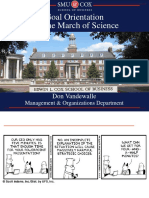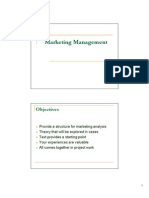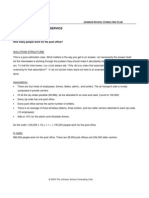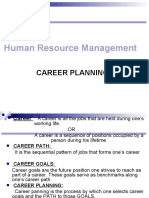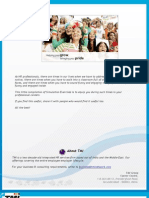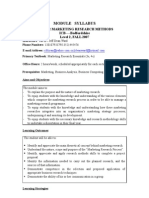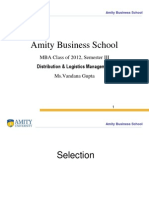Strategic Quality Management: .. Semester III 40 Contact Hrs. 4 Credits
Strategic Quality Management: .. Semester III 40 Contact Hrs. 4 Credits
Uploaded by
Vikram BindalCopyright:
Available Formats
Strategic Quality Management: .. Semester III 40 Contact Hrs. 4 Credits
Strategic Quality Management: .. Semester III 40 Contact Hrs. 4 Credits
Uploaded by
Vikram BindalOriginal Title
Copyright
Available Formats
Share this document
Did you find this document useful?
Is this content inappropriate?
Copyright:
Available Formats
Strategic Quality Management: .. Semester III 40 Contact Hrs. 4 Credits
Strategic Quality Management: .. Semester III 40 Contact Hrs. 4 Credits
Uploaded by
Vikram BindalCopyright:
Available Formats
Amity Business School
Strategic Quality Management
..
Semester III 40 Contact Hrs. 4 Credits
Amity Business School
Transition from Old to New age Policies
Philosophy of integrating market driven focus elements for continuous improvement in all work processes of the enterprise becomes necessary due to: Customer driven market revolution Fierce global competition Unpredictable market, changing expectations & moving targets Need to develop a customer focused culture Integrate market driven culture Focus on quality, cost, productivity Customer loyalty & Change Management
Amity Business School
Evaluation of Competitive Capabilities
What is that you do that the customers value better than the competition Evaluation of your resources is of no value unless done in respect to your competitors If you are not the best in a critical activity, you are sacrificing the competitive advantage by continuing to do what you are doing with old practices Only the firms that are able to continually build new strategic assets faster and cheaper than the competition will earn superior customer value and returns over long period
Amity Business School
Focus Elements of a Market Driven Enterprise
Commitment to customer satisfaction Human Resource Development Total Quality Culture Error Prevention Philosophy Zero Error Solutions Design & Product Quality Quality Services Quality of Management & Services People Development Productivity, efficiency and effectiveness Process & Technologies for continuous improvement
Amity Business School
Total Quality Management
concepts & understanding
TQM is a philosophy that represents a set of guiding principles that lays the foundation of a continuously improving and customer driven organization
The first job we have is to turn out quality merchandise that consumers will buy and keep on buying. If we produce it efficiently and economically, we will earn a profit, in which you will share. - William Cooper Procter
Amity Business School
TQM IS Encompassing and mobilizing entire organization to satisfy the customer Improving each individual and groups within the organization Integrating the philosophy and practices in day to day approach to work Influencing all product, services, systems, process & technology Long term and continuous and is sensitive to the social responsibilities of the enterprise Supporting High Performance Culture through teamwork, trust & leadership IT IS NOT A program, that has a beginning & an end. It is a continuous journey.
Amity Business School
History
Craftsmen Early days, generations learning, own inspector. Early 20th Century Unskilled repetitive, start of interchangeability. Ford Story. Standardization, concepts for quality, Mass Mfg. Post War.. American Society for Quality 1944
Safety, Public interest producer beware
Dr. Joseph Juran & Dr. Edward Demming story
Pioneering work in Total Quality ( in Japan ) Demming returns to US (1980-1993)
Product Quality to Performance Excellence
Quality of Management as important as Management of Quality
American Society for Quality identifies future challenges Partnering, Learning system, Adaptability and speed of change Environmental Sustainability, Knowledge Focus, Globalization Customization & Differentiation, Shifting Demographics
Amity Business School
Journey to TQM.
TQM All Employees involved Empowerment Teamwork Quality Strategy
Quality Assurance Quality Systems ISO Quality Planning Quality Policy Quality Controls Problem Solving
Quality Control
Quality Standards Statistical Controls Process Performance Treat Quality Problems
Inspection Error Detection Rectification Unhappy Customer
Amity Business School
History of Quality ( Contd.)
Quality awareness in U.S. manufacturing industry during 1980s: from Little Q to Big Q - Total Quality Management
Malcolm Baldrige National Quality Award (1987) Disappointments and criticism
Amity Business School
History of Quality ( Contd.)
Emergence of quality management in service industries, government, health care, and education
Evolution of Six Sigma Current and future challenge: keep progress in quality management alive
10
Amity Business School
Contemporary Influences on Quality
Partnering Learning systems Adaptability and speed of change Environmental sustainability Globalization Knowledge focus Customization and differentiation Shifting demographics
Amity Business School
Definitions of Quality
Transcendent definition: excellence
Product-based definition: quantities of product attributes
User-based definition: fitness for intended use
Value-based definition: quality vs. price Manufacturing-based definition: conformance to specs
12
Amity Business School
Quality Perspectives
transcendent & product-based user-based
needs
Customer
value-based
Marketing
products and services
Design
manufacturingbased
Manufacturing Distribution
Information flow Product flow
13
Amity Business School
Paradigm Shift
From.
Management of Quality
to
Quality of Management
Amity Business School
Malcolm Baldrige
Criteria
Leadership Strategic Planning Customer & Market Focus Information & Analysis Human Resources Development & Planning Process Management Business Results
Weightage 12% 8% 8% 8% 10% 10% 44%
Amity Business School
Understanding of Criteria
1. Leadership Leadership System.. How the senior leaders guide the company in setting directions and in developing and sustaining an effective leadership system. Company Responsibility & Citizenship How the company addresses the its responsibility to the public and how it practices good citizenship. Strategic Planning Strategy Development Process.. How the company sets strategic directions to better define and strengthen its competitive position and how the development process leads to action plan for deploying and aligning key plan and performance requirements. Company Strategy.. How the performance requirements and measures align with the human resource plan and how the plans project the cos future as compared to the competitors and key benchmarks. Customer & Market Focus Customer & Market Knowledge.. How the company determines the long term requirements and preference of target and potential customers and market and anticipate needs to develop business opportunities . Customer Relationship & Satisfaction Enhancement..How the company determines and enhances the satisfaction of customers to strengthen relationships to improve current offerings and to support customer and market related planning.
2.
3.
Amity Business School
Understanding of Criteria (contd.)
4. Information & Analysis Selection & Use of Information & DataHow the co. selects, manages and uses the information and data needed to support key company process and improve the cos performance. Selection & use of comparative information & data.. How the company selects, manages and uses comparative information data to improve cos competitive position. Analysis & Review of Companys Performance..How the co. analyses and reviews overall performance to assess the progress relative to plans to identify key areas of improvement. 5. Human Resources Development & Management Work Systems.. What is the companys work & job design and its compensation and recognition approaches to enable and encourage all employees to contribute effectively to achieve the cos performance and learning objective. Employee Education Training & Development.. How the cos training and education addresses its plan and needs including building knowledge & capabilities & contribute to improved employees performance and development. Employee Well-Being & Satisfaction..How the company maintains its work environment and work climate to support the well-being, satisfaction and motivation of all its employees
Amity Business School
Understanding of Criteria ( Contd.)
6. Process Management Management of Product & Service Processes..How the significantly modified and customized products and services are designed. How the product/services delivery systems are designed, implemented and improved. Management of Support Process.. How the cos key support processes are designed, managed and continuously improved. Management of Supplier and Partnering..How the cos supplier and partnering processes, performance and relationships are managed and improved. 7. Business Results Customer Satisfaction Results..How the co. performance on Customer Satisfaction Financial & Market Results.Cos key financial & marketplace performance Human Resource ResultsCos Human Resource results including employee wellbeing, satisfaction, development and work system performance Supplier & Partner ResultsCos supplier and partner results Company-Specific ResultsHow the companys key operational performance and results significantly contribute to key company goals- customer satisfaction, operational effectiveness and financial/market place and performance.
Amity Business School
Leadership
The ability to positively influence people and systems under ones authority to have a meaningful impact and achieve important results
Amity Business School
The Baldrige Leadership Triad
Strategic Planning
Leadership
Operations
Customer and Market Focus
Amity Business School
Executive Leadership
Defining and communicating business directions Ensuring that goals and expectations are met Reviewing business performance and taking appropriate action Creating an enjoyable work environment Soliciting input and feedback from customers Ensuring that employees are effective contributors Motivating, inspiring, and energizing employees Recognizing employee contributions Providing honest feedback
Amity Business School
Key Idea
Effective leadership requires five core leadership skills:
vision
Empowerment
Intuition self-understanding and value congruence.
Amity Business School
Leading Practices Leadership
Create a customer-focused strategic vision and clear quality values Create and sustain leadership system and environment for empowerment, innovation, and organizational learning Set high expectations and demonstrate personal commitment and involvement in quality Integrate quality values into daily leadership and management and communicate extensively Review organizational performance Create an environment and governance system that fosters legal and ethical behavior Integrate public responsibilities and community support into business practices
23
Amity Business School
Leadership System
Leadership System .. how decisions are made, communicated, and carried out at all levels; mechanisms for leadership development, self-examination, and improvement Effectiveness of Leadership System depends in part on its organizational structure
24
Amity Business School
Key Idea
An Effective Leadership System respects the capabilities and requirements of employees and other stakeholders, and sets high expectations for performance and performance improvements.
Amity Business School
Governance
Governance . The system of management and controls exercised in the stewardship of an organization.
Approving strategic direction Monitoring and evaluating CEO performance Succession planning Financial auditing Executive compensation Disclosure Shareholder reporting
Amity Business School
Leadership and Social Responsibilities
Ethics Health, safety, and environment Community support
Amity Business School
Key Idea
Practicing good citizenship refers to leadership and supportwithin the limits of an organizations resourcesof publicly important purposes, including improving education, community health, environmental excellence, resource conservation, community service, and professional practices.
Amity Business School
Leadership
Definition
..TQM relevance
Traditional Leadership for Quality Assortment of behaviors vision, hope, stimulation, mission, transformation dreams to reality, stewardship, Integration, courage, communication, consensual, conviction, empowering deploying, motivating, motivating and tenacity. Executive Leadership-not the only one Changed Business Scenario & New Economy demanding Unit, Team, Project and Transformational Leadership No more the one or few men show Strategic Plan Integration Quality is the key element to strategic planning for Quality management and Performance Excellence under the current business environment Identification of such competitive advantages that is driven by customer and market.
Amity Business School
Leadership
Effective Leadership
..TQM relevance
Five Core Skills vision, empowerment, intuition, self-understanding & value congruence
Leadership Practices
Customer Focus, Strategic vision, Quality value Creating sustainable leadership, environment, empowerment, innovate Setting high expectations, demonstrate substantial personal commitment and involvement, missionary zeal and constancy of purpose Integrating quality values in daily values, extensive communication Integrate public responsibility and community support in business practices
TQ Leadership Contrasts.. Details Leadership & Public Responsibilities
Public Health, safety & environment Compliance Corporate Citizenship, Community education, welfare, conservation Industry Obligation to Community
Amity Business School
TQ Leadership Contrasts
Traditional
Plan Projects Make plans Organize resource Preach M.B.O Push Products Lip service to quality Sell to customer Perform R&D Control People Control through systems Reward conformance punish deviation Maintain status QUO
TQ Leaders
Practice Envision the future Optimize the resource Participative management Produce Exemplary quality Service the customer Innovate Motivate people Development, talent & system Reward effort, skill development and empower Continuous improvement
Amity Business School
Strategic Planning
The process of envisioning organizations future and developing necessary procedures and operations to shape and achieve that future
Concept
Plan that integrates an organizations major goals Policies and actions sequences in alignment and supporting the goals Marshalling and allocating organizations resources into an unique and viable posture Based on ones relative strengths and competencies and anticipated changes in the environment Counter measures and actions anticipating contingent moves by intelligent opponents
Amity Business School
Strategic Planning
Influence of TQ culture
Leading Practices Top management, employees & even customers actively participate in the planning process Systematic planning process for strategy development and deployment including measurement, feedback and review. Gathering and analysis of variety of data external & internal factors Alignment of short-term action plans with long term strategic objectives. Derive human resource plans from strategic objectives and action plans
Vision Mission Guiding Principle
Strategy Development
Environmental Scan
Strategies
Objectives
Action Plans
Amity Business School
Mission
Definition of products and services, markets, customer needs, and distinctive competencies
Solectron: to provide worldwide responsiveness to our customers by offering the highest quality, lowest total cost, customized, integrated, design, supply chain, and manufacturing solutions through long-term partnerships based on integrity and ethical business practices.
Amity Business School
Vision
.Where the organization is headed and what it intends to be.
Brief and memorable - grab attention Inspiring and challenging - creates excitement Descriptive of an ideal state - provides guidance Appealing to all stakeholders - employees can identify with
Solectron:
Be the best and continuously improve
Amity Business School
Values (Guiding Principles)
Defines attitudes and policies for all employees, which are reinforced through conscious and subconscious behavior at all levels of the organization.
Pepsico:
Integrity, Honesty, Teamwork, Balance, Accountability Whirlpool: Respect, Integrity, Teamwork, Trust
Leadership, Customer Passion
Amity Business School
Environmental Assessment
TEMPLES or PESTLE
Customer and market requirements, expectations and opportunities Technological and other innovations Organizational strengths and weaknesses Financial, societal, ethical, regulatory and other potential risks Changes in global or national economy Factors unique to the organization, such as partner and supply chain needs
Amity Business School
Key Idea
Strategies are broad statements that set the direction for the organization to take in realizing its mission and vision. Strategic objectives are what an organization must change or improve to remain or become competitive. Action plans are things that an organization must do to achieve its strategic objectives.
Amity Business School
Strategic Deployment
TQ way
Converting the strategies into small doable goals and then ultimately deployed to the right teams & people in form of SMART objectives
Balance Scorecard Hoshin Kanri or Hoshin Planning or Policy Deployment Management by Planning
Team based deployment is most suited to TQ environment
Amity Business School
Policy Deployment (Hoshin Kanri)
Top management vision leading to long-term objectives Deployment through annual objectives and action plans Negotiation for short-term objectives and resources (catchball) Periodic reviews
40
Amity Business School
Leadership and Organizational Structure
Basic types of organizational structures Line organization Line and staff organization Matrix organization
Amity Business School
Key Idea
As more and more companies accept the process view of organizations, they are structuring the quality organization around functional or cross-functional teams.
Amity Business School
Caliberations
Strategic Planning
What the auditor will look for
Customer & market driven quality integrated into bloodstream Integrated into the product, operations and service processes Operational Excellence to deliver on above
Deployment
Deployment to the right people with smart objectives Organizations ability to translate strategic objective into action plans TQ aspects include Empowerment Diffused Leadership Institutionalized Learning Innovation and Experimentation
Customer Driven Quality TQM way to implement strategy Operational Excellence
Amity Business School
Focusing on Customers
44
Amity Business School
Key Idea
To create satisfied customers, the organization needs to identify customers needs, design the production and service systems to meet those needs, and measure the results as the basis for improvement.
Amity Business School
Importance of Customer Satisfaction and Loyalty
Satisfaction is an attitude; loyalty is a behavior Loyal customers spend more, are willing to pay higher prices, refer new clients, and are less costly to do business with. It costs five times more to find a new customer than to keep an existing one happy. A firm cannot create loyal customers without first creating satisfied customers.
46
Amity Business School
Key Idea
Customer wants and needs drive competitive advantage, and statistics show that growth in market share is strongly correlated with customer satisfaction.
Amity Business School
Customer Satisfaction Model
Perceived quality Perceived value Customer complaints
Customer satisfaction Customer loyalty
Customer expectations
Amity Business School
Customer-Driven Quality Cycle
Customer needs and expectations (expected quality) Identification of customer needs Translation into product/service specifications (design quality) Output (actual quality) Customer perceptions (perceived quality)
measurement and feedback
PERCEIVED QUALITY is a comparison of ACTUAL QUALITY to EXPECTED QUALITY
49
Amity Business School
Key Idea
Many organizations still focus more on processes and products from an internal perspective, rather than taking the perspective of the external customer.
Amity Business School
Leading Practices
Define and segment key customer groups and markets Understand the voice of the customer (VOC) Understand linkages between VOC and design, production, and delivery Build relationships through commitments, provide accessibility to people and information, set service standards, and follow-up on transactions Effective complaint management processes Measure customer satisfaction for improvement
Amity Business School
Key Customer Groups
Organization level
consumers external customers employees society
Process level
internal customer units or groups
Performer level
individual internal customers
Amity Business School
Identifying Internal Customers
What products or services are produced? Who uses these products and services? Who do employees call, write to, or answer questions for? Who supplies inputs to the process?
Amity Business School
AT&T Customer-Supplier Model
Your Suppliers
Inputs
Your Processes
Outputs
Your Customers
Requirements and feedback
Requirements and feedback
54
Amity Business School
Key Idea
The natural customer-supplier linkages among individuals, departments, and functions build up the chain of customers throughout an organization that connect every individual and function to the external customers and consumers, thus characterizing the organizations value chain.
Amity Business School
Customer Segmentation
Demographics Geography Volumes Profit potential
Amity Business School
Key Idea
Segmentation allows a company to prioritize customer groups, for instance by considering for each group the benefits of satisfying their requirements and the consequences of failing to satisfy their requirements.
Amity Business School
Key Dimensions of Quality
Performance primary operating characteristics Features bells and whistles Reliability probability of operating for specific time and conditions of use Conformance degree to which characteristics match standards Durability - amount of use before deterioration or replacement Serviceability speed, courtesy, and competence of repair Aesthetics look, feel, sound, taste, smell
Amity Business School
Key Dimensions of Service Quality
Reliability ability to provide what was promised Assurance knowledge and courtesy of employees and ability to convey trust Tangibles physical facilities and appearance of personnel Empathy degree of caring and individual attention Responsiveness willingness to help customers and provide prompt service
59
Amity Business School
Kano Model of Customer Needs
Dissatisfiers: expected requirements Satisfiers: expressed requirements Exciters/delighters: unexpected features
60
Amity Business School
Key Idea
As customers become familiar with them, exciters/delighters become satisfiers over time. Eventually, satisfiers become dissatisfiers.
Amity Business School
Customer Listening Posts
Comment cards and formal surveys Focus groups Direct customer contact Field intelligence Complaint analysis Internet monitoring
62
Amity Business School
Key Idea
Companies use a variety of methods, or listening posts, to collect information about customer needs and expectations, their importance, and customer satisfaction with the companys performance on these measures.
Amity Business School
Tools for Classifying Customer Requirements
Affinity diagram Tree diagram
Amity Business School
Moments of Truth
Every instance in which a customer comes in contact with an employee of the company.
Example (airline)
Making a reservation Purchasing tickets Checking baggage Boarding a flight Ordering a beverage Requests a magazine Deplanes Picks up baggage
Amity Business School
Key Idea
An organization builds customer loyalty by developing trust, communicating with customers, and effectively managing the interactions and relationships with customers through approaches and its people. Companies must carefully select customer contact employees, train them well, and empower them to meet and exceed customer expectations.
Amity Business School
Customer Relationship Management
Accessibility and commitments Selecting and developing customer contact employees Relevant customer contact requirements Effective complaint management Strategic partnerships and alliances Exploiting CRM technology
Amity Business School
Key Idea
To improve products and processes effectively, companies must do more than simply fix the immediate problem. They need a systematic process for collecting and analyzing complaint data and then using that information for improvements.
Amity Business School
Measuring Customer Satisfaction
Discover customer perceptions of business effectiveness Compare companys performance relative to competitors Identify areas for improvement Track trends to determine if changes result in improvements
69
Amity Business School
Key Idea
An effective customer satisfaction measurement system results in reliable information about customer ratings of specific product and service features and about the relationship between these ratings and the customers likely future market behavior.
Amity Business School
Survey Design
Identify purpose Determine who should conduct the survey Select the appropriate survey instrument Design questions and response scales
Amity Business School
Key Idea
The types of questions to ask in a survey must be properly worded to achieve actionable results. By actionable, we mean that responses are tied directly to key business processes, so that what needs to be improved is clear; and information can be translated into cost/revenue implications to support the setting of improvement priorities.
Amity Business School
Performance-Importance Analysis
Performance
Low High
Low High
Who cares?
Overkill
Importance
Vulnerable
Strengths
Amity Business School
Key Idea
Appropriate customer satisfaction measurement identifies processes that have high impact on satisfaction and distinguishes between low performing processes low performance and those that are performing well.
Amity Business School
Difficulties with
Customer Satisfaction Measurement
Poor measurement schemes Failure to identify appropriate quality dimensions Failure to weight dimensions appropriately Lack of comparison with leading competitors Failure to measure potential and former customers Confusing loyalty with satisfaction
Amity Business School
Customer Perceived Value
CPV measures how customers assess benefits such as product performance, ease of use, or time savingsagainst costs, such as purchase price,installation cost or time, and so on,in making purchase decisions.
Amity Business School
CUSTOMER LOYALTY RELATIONSHIPS
Non-competitive zone Regulated, Monopoly or few substitutes. Dominant Brand Equity. High cost of switching. Powerful Loyalty Prog. Proprietary Technology. Highly competitive zone. Commoditization or low differentiation. Consumer Indifference. Many substitutes. Low cost of Switching
Relationship of Customer Satisfaction and Profitability Total Satisfaction for captive customers Tyranny of Averages Satisfying Target Segments Ultimate Source of Focus: affinity Groups
Amity Business School
THE IMPORTANCE OF FOCUS
Organization that have not identified the customers they are targeting have a special handicap in achieving total customer satisfaction and create many merely satisfieds.
Customer tell about only extra-ordinary experience Only on third of the dissatisfied tell but the talk alright.
You might also like
- Why Is It Hard To Be A Connector ManagerDocument1 pageWhy Is It Hard To Be A Connector Managerdhruv.dm253031No ratings yet
- INSEAD 2011 BrochureDocument32 pagesINSEAD 2011 Brochuretheseus1422No ratings yet
- EY Case BDocument6 pagesEY Case B354Prakriti SharmaNo ratings yet
- Eli Lilly - A Case AnalysisDocument18 pagesEli Lilly - A Case AnalysisAthayaSekarNovianaNo ratings yet
- Preparing For Interviews - Entrepreneur First SGDocument2 pagesPreparing For Interviews - Entrepreneur First SGGioNo ratings yet
- Mysore Foods LimitedDocument3 pagesMysore Foods LimitedBhavdeepsinh JadejaNo ratings yet
- Parchaya Pustika of FemaleDocument140 pagesParchaya Pustika of FemaleVikram BindalNo ratings yet
- Summer Internship Booklet For StudentsDocument31 pagesSummer Internship Booklet For StudentsRubina MansooriNo ratings yet
- EY Case Study - Ernst BankDocument9 pagesEY Case Study - Ernst BankHaris FadžanNo ratings yet
- Goal OrientationDocument13 pagesGoal Orientationmadya sulisnoNo ratings yet
- Topic 3-Qualities of A ConsultantDocument7 pagesTopic 3-Qualities of A ConsultantWeru CharlesNo ratings yet
- IESE Executive MBA BrochureDocument28 pagesIESE Executive MBA Brochurejorge rocoNo ratings yet
- Marketing OverviewDocument9 pagesMarketing OverviewGourav SihariyaNo ratings yet
- How To Solve A Case StudyDocument3 pagesHow To Solve A Case Studyshazeb zafarNo ratings yet
- Syllabus - ET5 - MM5026 - Management of Innovation Technology and EntrepreneurshipDocument15 pagesSyllabus - ET5 - MM5026 - Management of Innovation Technology and Entrepreneurshipandi2405No ratings yet
- 2003 Cornell Johnson CC Case BookDocument92 pages2003 Cornell Johnson CC Case Bookr_okoNo ratings yet
- Campus Connexions - CorporateDocument37 pagesCampus Connexions - CorporateNisha AnandNo ratings yet
- Mconsultingprep Com Case InterviewDocument72 pagesMconsultingprep Com Case InterviewTestNo ratings yet
- How To Answer 14 Common But Tricky Interview QuestionsDocument5 pagesHow To Answer 14 Common But Tricky Interview Questionsjennifer L. TUtorNo ratings yet
- 20mia1126 Da 1Document4 pages20mia1126 Da 1Chenchu AravindNo ratings yet
- How To Ace Your InterviewDocument42 pagesHow To Ace Your InterviewNeha ChoudharyNo ratings yet
- Englishscore Reading PracticeDocument8 pagesEnglishscore Reading PracticeANISA IQLIMA DAMAYANTINo ratings yet
- Kellog Interview GuideDocument17 pagesKellog Interview GuidefredsgaoNo ratings yet
- FitzsimmonsMKT382Document27 pagesFitzsimmonsMKT382Carlos Delgado Nieto100% (1)
- Behavioral Interview Fit MatrixDocument31 pagesBehavioral Interview Fit MatrixAdithi RajuNo ratings yet
- I Needed To Upload This For The Indian GuesttimatesDocument153 pagesI Needed To Upload This For The Indian GuesttimatesMatthiasNo ratings yet
- Work Book Resume ExercisesDocument20 pagesWork Book Resume ExercisesAbhishek SharmaNo ratings yet
- Human Resource Management: Career PlanningDocument29 pagesHuman Resource Management: Career Planningfaizanahmadnazir4309No ratings yet
- Case InterviewDocument16 pagesCase Interviewkalyantj100% (1)
- Chapter 3 - Customer Relationship Management - Group 3Document28 pagesChapter 3 - Customer Relationship Management - Group 3Irfan Affandi100% (1)
- ISB 2004 Consulting Case Book and Sample ResumeDocument134 pagesISB 2004 Consulting Case Book and Sample ResumeVignesh NarayananNo ratings yet
- Interview QuestionsDocument47 pagesInterview QuestionsashudadhichNo ratings yet
- Business Strategy AssignmentDocument14 pagesBusiness Strategy AssignmentKhalid Javaid Anwer0% (1)
- Retail Book Chap10Document23 pagesRetail Book Chap10Harman Gill100% (2)
- Principles of Management Final Project GuidlinesDocument2 pagesPrinciples of Management Final Project GuidlinesAiman Fatima100% (1)
- SPJIMR Consulting Casebook 2014 PDFDocument166 pagesSPJIMR Consulting Casebook 2014 PDFAvdesh Kothari100% (1)
- What Is Sustainability in Business - HBS OnlineDocument6 pagesWhat Is Sustainability in Business - HBS OnlineKimanh TranNo ratings yet
- UNC Kenan Flagler Essays 2Document2 pagesUNC Kenan Flagler Essays 2Swetha VasuNo ratings yet
- Strategic Management: Submitted by Nikita Saini Mba 4 1803104025Document46 pagesStrategic Management: Submitted by Nikita Saini Mba 4 1803104025KBC KGFNo ratings yet
- Accenture Interview 1Document4 pagesAccenture Interview 1Kisa MarkisaNo ratings yet
- Simulation ExercisesDocument158 pagesSimulation ExercisesRajesh KumarNo ratings yet
- CIPS Strategy AnalysisDocument9 pagesCIPS Strategy AnalysisSalman ZafarNo ratings yet
- Strategic and Planning Issues in NegotiationDocument24 pagesStrategic and Planning Issues in NegotiationJaideip KhaatakNo ratings yet
- Note To The Reader: Dear Consulting Club MemberDocument95 pagesNote To The Reader: Dear Consulting Club Memberimage05No ratings yet
- GUIDES To Grenier ModelDocument7 pagesGUIDES To Grenier ModelAyesha SiddiquaNo ratings yet
- CRM - Lesson 11 - CRM Metrics (4186)Document24 pagesCRM - Lesson 11 - CRM Metrics (4186)Rishabh JainNo ratings yet
- Strategic Storytelling - SummaryDocument6 pagesStrategic Storytelling - SummaryyashviandbooksNo ratings yet
- Marketing Research MethodsDocument4 pagesMarketing Research Methodsrajesh3785No ratings yet
- BCG and GeDocument16 pagesBCG and GekaurmaanNo ratings yet
- Crisil Interview QuestionsDocument7 pagesCrisil Interview QuestionsNagarajanRKNo ratings yet
- The ("Dreaded") Case Interview: Caltech Consulting ClubDocument16 pagesThe ("Dreaded") Case Interview: Caltech Consulting ClubPatrick Mxolisi NkomoNo ratings yet
- Deloitte Uk Hints and Tips HRDocument6 pagesDeloitte Uk Hints and Tips HRJames CheungNo ratings yet
- Strategic Thinking: Unlocking the Power of Long-Term PlanningFrom EverandStrategic Thinking: Unlocking the Power of Long-Term PlanningNo ratings yet
- Elevate Customer Experience: Your Blueprint for CX ExcellenceFrom EverandElevate Customer Experience: Your Blueprint for CX ExcellenceNo ratings yet
- ONS Accredited Researcher Record: Accurate As of 31st November 2017Document221 pagesONS Accredited Researcher Record: Accurate As of 31st November 2017Vikram BindalNo ratings yet
- Judge Duty Roster Wef011020southeast - 0Document3 pagesJudge Duty Roster Wef011020southeast - 0Vikram BindalNo ratings yet
- Domestic & NRI Saving Account Interest Rates: (W.E.F. 1st September 2020)Document4 pagesDomestic & NRI Saving Account Interest Rates: (W.E.F. 1st September 2020)Vikram BindalNo ratings yet
- Circular Webex - 0Document3 pagesCircular Webex - 0Vikram BindalNo ratings yet
- Mark Singh: Key StrengthsDocument5 pagesMark Singh: Key StrengthsVikram BindalNo ratings yet
- How To Find Ctos With Boolean Search StringsDocument3 pagesHow To Find Ctos With Boolean Search StringsVikram BindalNo ratings yet
- Circular Webex - 0Document3 pagesCircular Webex - 0Vikram BindalNo ratings yet
- Amity Business School: MBA Class of 2012, Semester IIIDocument12 pagesAmity Business School: MBA Class of 2012, Semester IIIVikram BindalNo ratings yet
- Doors Widen To The West: China's Entry in The World Trade Organization Will Ease Some Restrictions On Foreign Law Firms Susan E. VitaleDocument29 pagesDoors Widen To The West: China's Entry in The World Trade Organization Will Ease Some Restrictions On Foreign Law Firms Susan E. VitaleVikram BindalNo ratings yet
- Fiscal FinalDocument35 pagesFiscal FinalVikram BindalNo ratings yet









